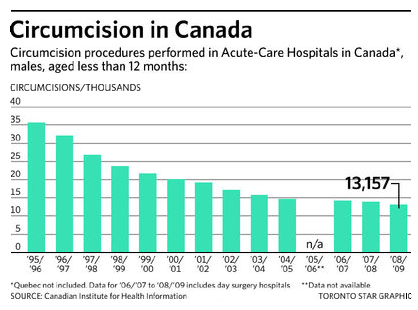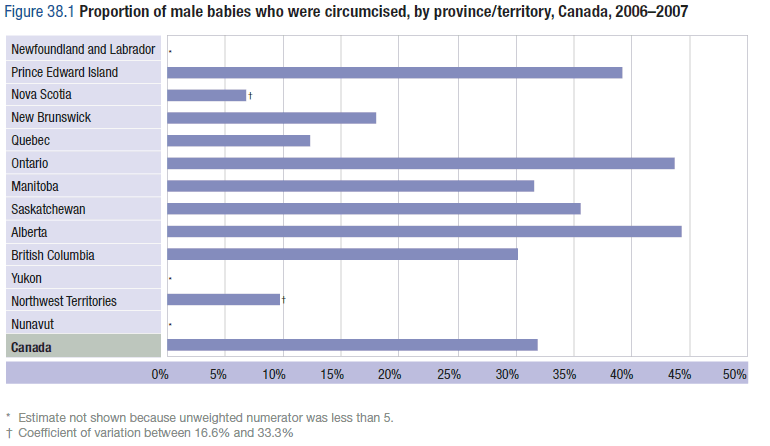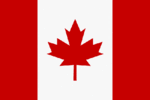The boundaries of the Provinces of Canada changed on 1st April 1999, consequent upon the creation of Nunavut, formerly part of the North-West Territories:

Although unlikely to have a profound effect on circumcision statistics, this change must be borne in mind when comparing data before and after the change. Other boundaries were unchanged. The francophone (French-speaking) part of Canada corresponds approximately with the boundaries of the Province of Québec, though French, of a sort, is also spoken on the other side of the continent in parts of British Columbia.
Canada & the USA - Cultural similarities and differences
Those of us who come from outside North America often make the mistake of thinking that Canada is some sort of adjunct to the USA, but a bit colder and a little more English. Not so. Healthcare, in particular, is quite different from the US model. That said, when it comes to circumcision, Canadians from the more westerly provinces (Manitoba, Saskatchewan, Alberta and British Colombia in particular) tend to regard circumcision as a matter of common practice thoughout the continent.The following quote comes from a post to the former Circlist Discussion Group in the 1990s:
There were several postings a few months ago concerning rates of circumcision in the various provinces of Canada. I had the impression that circumcision was a much less common practice in all but Ontario province. This past weekend I met a colleague who practices in Alberta and is preparing a study. He shared with me the perceptions of adolescent males he treats concerning circumcision. It seems that, at least in southern Alberta, in a radius of 100 miles around Calgary, most teenage males identified themselves as being circumcised and perceive the practice to be universal in Canada. The opinions sampled included athletes who compete in Canadian national sports. I quizzed him specifically on this point and his reaction was “Listen, while Canadians may differ from Americans in many respects, they are still North Americans with regard to this subject”. He, incidentally, identifies himself as an uncircumcised male born in the Francophone (Montreal) region.
M.Witt, PhD (undated, circa 1999)
The present editor had a Canadian flatmate around 1970. He was from Edmonton, Alberta, and also regarded circumcision as universal in Canada.
The Canadian healthcare system and its effect on circumcision rates.
Since 1966, Canada has had a unified, state-funded healthcare system administered at provincial level. Qualifying patients do not pay to visit their doctor; administrations in each province regulate the cost which is then reimbursed by the federal government. In broad terms it can be thought of as a state-run health insurance scheme with premiums funded through taxation, the central government dispensing funds to the provincial governments through the mechanism of the Canada Health Transfer. The current (2010) legislative framework is the Canada Health Act 1984.
One consequence of the 1984 legislation was that routine infant circumcision ceased to be paid for by the Canadian government. In this respect Canada was following in the steps of the United Kingdom’s National Health Service, deeming circumcision to be a cosmetic or cultural matter (not covered in either country) rather than a “preventative” service which, according to a strict interpretation of the legislation, would qualify in both.
The incidence of routine infant circumcision did not immediately change and may have increased immediately after the procedure was delisted. The following study was published in 1997 (R. E. Walton et al.):
OBJECTIVE: To determine the prevalence of neonatal circumcision immediately following delisting of the procedure in Ontario and to examine parents’ knowledge, attitudes, and behaviours regarding circumcision.
DESIGN: Cross-sectional survey.
SETTING: Perinatal tertiary care centre in southwestern Ontario.
PARTICIPANTS: Of the 151 mothers approached, three were excluded because they did not speak English and two declined participation; 112 of 146 mothers of healthy male newborns responded [resulting in] a response rate of 77%.
RESULTS: The circumcision rate before delisting had been 56.2%; in the months immediately after, the rate was 59.8% (95% confidence interval was 51%, 69%). Mothers of infants in the outcome groups did not differ significantly in any demographic feature other than education, where the group deciding against circumcision reported higher education levels. Mothers who chose circumcision listed medical (59%) and sociocultural considerations (40%) as most important to their decision. Father’s circumcision status was strongly associated with the infant’s (chi-squared [df 1] = 25.13, P = 0.0001). 74% discussed circumcision with their family physicians prior to requesting the procedure.
CONCLUSIONS: The prevalence of neonatal circumcision did not change significantly after delisting.
Apparently in conflict with Walton’s findings, Canadian routine infant circumcision rates in hospitals are below 10% and continuing to decline. According to the Canadian Institute for Health Information (CIHI), 35,731 male infants were circumcised in Canadian hospitals in 1995-1996, while just 13,157 infants were circumcised in 2008-2009. But, as ever, one needs to be very careful of official statistics regarding circumcision. These numbers relate only to circumcisions of infants under one year of age circumcised in “Acute Care” (major) hospitals, so these figures don’t tell the whole story.

While the number of neonatal circumcisions performed in hospitals is falling, more parents are having their sons circumcised either at home or in the local doctor’s office. Either way, in the absence of medical need they are paying and the non-hospital settings cost less. Therefore their choice is unsurprising. Furthermore, as the number of infant circumcisions drops so the number needing it in childhood, teens or young adulthood rises, so we are not seeing the full story.
The website Parentcentral.ca reported in 2010 the opinion of Dr. Jorge DeMaria (a pediatric urologist at McMaster Children’s Hospital) that 50% of male infants are circumcised in Ontario when one includes those done in doctor’s offices or at parents’ homes. The Parentcentral.ca website no longer exists, but the whole controversy that it documented back in 2010 can be recovered from The Wayback Machine.
A major survey of maternal opinions on giving birth was conducted in Canada in 2009. What Mothers Say: The Canadian Maternity Experiences Survey Its findings broadly confirm Dr. DeMaria's views.

We can see that there are huge differences between provinces. Circumcision rates in Alberta and Ontario were around 44%, while two provinces, Nova Scotia and NW Territories were below 10%. Overall, 32% of Canadian babies were circumcised.
Circlist Member Comments
As a Canadian physician who has worked for 10 years with venereal diseases, I’d say that circumcision is absolutely necessary. People who don’t circumcise their boys are playing with fire. I’ve seen incredible infections in uncircumcised males, and I think it’s crazy not to do the procedure. I circumcise all boys in my care.
----------------------------I’m a busy family doctor in Southern Ontario. I think the real issue here is why we’re fussing about circumcisions at all. Women want their breasts propped up and their facial skin tightened. Men want penile prostheses and hair transplants. If people want circumcisions, providing the risks are controlled, let them pay and let them have it.
----------------------------
Even though I’m Jewish and I circumcised my son for religious reasons, I must admit I increasingly find myself having doubts about the necessity of it. Yet I think it’s reasonable to leave it up to parents, because I don’t believe that circumcising a child causes severe or lasting trauma or results in any major disadvantage. Still, I suspect that over time, although it may take a few generations, we’ll see circumcision go by the wayside.
----------------------------
There are fads in medicine, just as there are in any other discipline, and today’s evidence indicates that perhaps circumcision isn’t a useful medical procedure. But circumcisions have been performed for thousands of years and one thing we know is that the procedure carries no inordinate risk. If parents wish to have their child circumcised, I don’t see how physicians can discourage them from doing it.
----------------------------
I think that circumcision should be done on all newborn Canadian boys. The risk of infection is real - one in 20 boys will require a circumcision at some time in their lives due to infection or other problems. As a psychiatrist, I’ve seen a number of boys and men who require circumcision later on; it’s quite a traumatic experience. Furthermore, the African research of Helen Ronald at the University of Manitoba shows that males who’ve been circumcised have a much lower rate of AIDS than males who haven’t undergone the procedure.
----------------------------
I’m a specialist who often deals with this area of medicine, particularly with problems which occur in uncircumcised adult males. If circumcision isn’t adequately assessed by the general population, it’s bound to fall into significant disfavour, which would be unfortunate. Healthcare professionals who discourage circumcision are generally only partially informed about the long-term risks and/or benefits of the procedure. For example, infections or penile cancer are a real concern, but they’re not the major problem. The major problem is recurrent balanoposthitis, which is both physically and socially crippling for the uncircumcised.
----------------------------
I’m a family doctor who’s been in solo practice for over 25 years. I have one son who is circumcised and three daughters. My husband is circumcised and I understand my son-in-law is circumcised. I’m a very strong advocate of circumcision. I see far too much suffering and problems with my male patients when they have to undergo adult circumcision. Or what about when people get older and need special attention? Orderlies aren’t retracting foreskins to ensure proper hygiene when people come into institutional care. Also, most mothers, certainly by the time the child is three, four or five, don’t touch the child’s penis or are very reluctant to do so. Anyway, I think it’s naive to assume that the average person practices good hygiene. Just look at the typical level of gum and teeth care in this country, for goodness sake!
----------------------------
My son who is now 7 months old, got circumcised at 2 weeks old. Ever since then circumcision has been a big thing for me.. I look at people and wonder if they are done or not... I wonder why they didn’t do it... I argue with my friends who seem to think that it doesn’t matter... but in my head I think sure it does! I’ve done so much studying online about it that my boyfriend probably thinks I’m a weirdo. I live in northern Ontario and I had to drive 1½ hours away to get it done for my son by the only person in northern Ontario that I know does it. He is about 80 years old. What’s going to happen when he passes away? Looking at the current circumcision rate in Ontario this fear seems unjustified. (Ed)
----------------------------
Brad, from York County, Ontario, writes:
On two occasions I kept “statistics”, gathered at the gym belonging to a University in south Ontario. My findings were as follows:
Of the 297 observations made in 1993, 71% were circumcised and 29% were uncircumcised.
Of the 114 observations made in 1994, 68% were circumcised, and 32% were uncircumcised.
Of the 307 observations made in 1998, 62% were circumcised, and 38% were uncircumcised.
The gym being attached to a university, the youngest persons I saw would have been around 18. I guess you noticed that the rates of uncircumcised guys are higher in the 1998 observations than in the 1993-4 ones. This is due, I think, to the higher number of uncut undergraduates in 1998 (i.e., persons born about 1978 to 1980).
Acknowledgements
The following resources were used in the preparation of this web page:
Personal testimony of members of the CIRCLIST discussion group.
References
R. E. Walton, T. Ostbye, and M. K. Campbell, 1997 Neonatal male circumcision after delisting in Ontario. Survey of new parents. Canadian Family Physician. 43 1241-1247.
Public Health Agency of Canada. What Mothers Say: The Canadian Maternity Experiences Survey. Ottawa, 2009.

